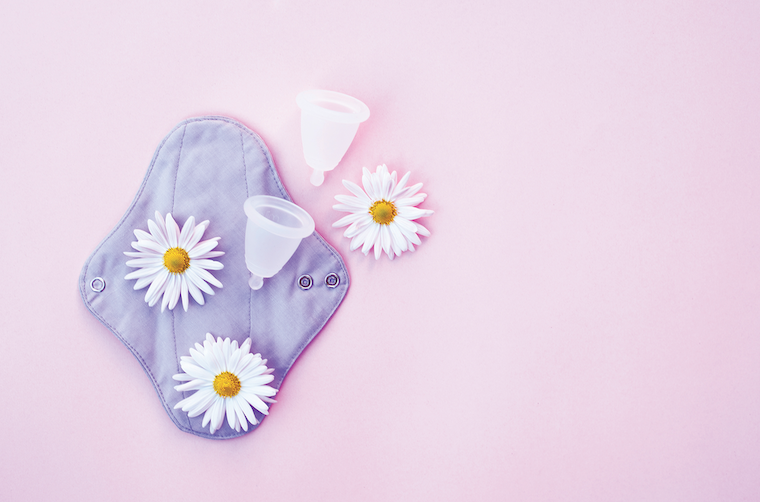The latest item missing from shelves: tampons (1).
The effects of COVID-19 are only one factor contributing to the tampon shortage. As Andre Schulten, Chief Financial Officer at Procter & Gamble, explained in aNew York Times article, sourcing raw materials for tampons/feminine hygiene products is proving to be “costly and highly volatile” (2). Also, transporting these products has become more expensive—the cost of shipping tampons from overseas is up 300% from 2021 (1).For people dealing with their periods, this is frustrating. For natural products retailers, though, itpresents an opportunity to serve customersin need…and support the health of the planet at the same time.
People who would normally reach for tampons may be even more open now to trying eco-friendly, reusable options such as menstrual cups and period underwear (2). Even before the latest shortages, experts were signaling that the need to do so would become more urgent.
“The COVID-19 pandemic has highlighted our dependency on single-use healthcare products worldwide, despite their increased cumulative costs, elevated susceptibility to supply chain strains, and significant environmental impacts,” medical students from McGill Faculty of Medicine and Health Sciences shared inThe BMJ Opinionin 2021 (3). They pointed out that, even before the pandemic, we have been facing “a tide of waste driven by the less commonly discussed single-use menstrual products such as tampons and pads.”
The Eco-Friendly Payoff
“Did you know that the average menstruating person uses 12,000 to 15,000 disposable period products in their lifetime? That’s about 250-300 pounds of waste,” notes Candace Allison, MPH, writing for Emory University’s Sustainability Initiatives blog (4).Consider this stat from the McGill experts: Consistent usage of reusable alternatives significantly reduces the amount of plastic waste generated. How significantly? Switching to options like menstrual cups and menstrual underwear cuts plastic waste generated by 99.6% in comparison with pads, and by 94% in comparison to tampons (3).
For those who aren’t particularly focused on the eco benefits, the benefit to their wallet may be appealing: Using accumulated estimates over 10 years, researchers reporting inThe Lancet compared purchase costs from consistent use of a menstrual cup with the cost of pads and tampons. Use of the cup would comprise 5% of the purchase costs of 12 pads per period, and 7% of the cost of 12 tampons per period (5).
A Healthier Option
The McGill experts outlined yet another reason to make the switch: “There is a growing body of literature that has identified notable health benefits for the use of menstrual cups.” These include, as presented in the BMJ article (3):-
Reduced prevalence of vaginal bacterial infections
-
Improved monitoring of menstrual flow to help manage patients with heavy menstrual bleeding.
-
Increased satisfaction relative to the continued use of tampons. They point to a trial in which 91% of women randomized to the menstrual cup group were willing to continue the use of the cup after the study period, and to recommend it to others.
Reusable, Sustainable Options
Menstrual cups:“Non-toxic and comfortable to use, for most people, menstrual cups are a great option,” shares health and wellness writer Leigh Matthews, BA Hons, H.Dip. NT, in her overview of options on LeafScore (6). “They typically last two to five years, making them a more eco-friendly, healthier, and inexpensive way to manage periods. With proper care, a single menstrual cup could last you decades.”Menstrual discs:Not quite as sustainable as cups, yet still a more planet-friendly alternative, discs can be used for up to 12 hours a time, and then get thrown away instead of being cleaned and reused. For people who aren’t sure about menstrual cups, Matthews says, “these discs can help test the fit and feel of using one before committing to a reusable cup while still being ultimately less wasteful than traditional disposable tampons” (6).
Period underwear:For those who favor pads, underwear options can be a perfect switch. “Made with absorbent natural fibers, period underwear can be worn with or without inserts for extra support and simply need rinsing in cold water and washing with your regular laundry after use,” Matthews explains (6). Since a goal is to be eco-friendly, Matthews adds: “Try to choose period underwear made with organic cotton though, as conventional cotton is resource-hungry, may contain traces of pesticides and other chemicals, and is bad for the environment.”
References
- https://time.com/6184644/tampon-shortage-supply-chain/
- https://www.nytimes.com/2022/06/22/style/tampon-shortage-alternatives.html
- https://blogs.bmj.com/bmj/2021/07/30/counselling-on-reusable-menstrual-products-an-opportunity-to-mitigate-climate-change-and-address-period-poverty-in-the-doctors-office/
- https://sustainability.emory.edu/how-zero-waste-can-save-you-money/
- https://www.sciencedirect.com/science/article/pii/S2468266719301112#bib13
- https://www.leafscore.com/eco-friendly-bath-products/non-toxic-menstrual-products/
- https://www.mindbodygreen.com/articles/pad-and-tampon-alternatives-that-are-better-for-earth/










